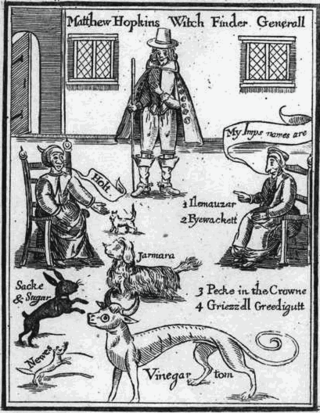Anna Maria Schwegelin was a maid alleged German (Bavarian) witch, long considered the last person to be convicted of witchcraft in the Holy Roman Empire, now modern-day Germany.
Marigje Arriens or Marichgen Ariaens was an alleged Dutch witch, long thought to be the last to be executed for sorcery in the Dutch Republic.
The witch trials of Vardø were held in Vardø in Finnmark in Northern Norway in the winter of 1662–1663 and were one of the biggest in Scandinavia. Thirty women were put on trial, accused of sorcery and making pacts with the Devil. One was sentenced to a work house, two tortured to death, and eighteen were burned alive at the stake.
Christence (Christenze) Akselsdatter Kruckow was a Danish noblewoman who was executed for witchcraft after having been accused twice. She is one of the most well known victims of the witch hunt in Denmark, and one of few members of the nobility to have been executed for sorcery in Scandinavia, and the only one in Denmark.
Anna Eriksdotter or Anna Ersdotter called Sotpackan, was a Swedish woman who was executed for witchcraft. She was the last person to be executed for witchcraft in Sweden.

Anne Palles was an alleged Danish witch. She was the last woman to be legally executed for sorcery in Denmark.
Peronne Goguillon was an alleged French witch. She and the other women who were accused with her are regarded the last women to have been burned at the stake for witchcraft in France.
Events in the year 1715 in Norway.
The Thisted witch trial, also known as Besættelsen i Thisted, took place in Thisted in Denmark in 1696–1698. It has been referred to as the last witch trial in Denmark, and the end of the belief in witchcraft among the Danish authorities.
Johanne Nielsdatter or Johanne Nilsdatter, was a Norwegian woman who was executed for witchcraft. Her execution is the last confirmed execution for witchcraft in Norway.
Anna Jansdochter Muggen, was an alleged Dutch witch. She was the last person to be executed for witchcraft in Holland, then the most influential province of the Netherlands. She has been referred to as the last person to be executed for witchcraft in the Netherlands.
Johan Pistorius, was a Danish grenadier. He was judged guilty of making a Satanic pact, and was the last person executed for witchcraft in Denmark.

Sweden was a country with few witch trials compared to other countries in Europe. In Sweden, about four hundred people were executed for witchcraft prior to the last case in 1704. Most of these cases occurred during a short but intense period; the eight years between 1668 and 1676, when the witch hysteria called Det stora oväsendet took place, causing a large number of witch trials in the country. It is this infamous period of intensive witch hunt that is most well known and explored.

The Witch trials in Denmark are poorly documented, with the exception of the region of Jylland in the 1609–1687 period. The most intense period in the Danish witchcraft persecutions was the great witch hunt of 1617–1625, when most executions took place, which was affected by a new witchcraft act introduced in 1617.
The witch trials in Norway were the most intense among the Nordic countries. There seems to be around an estimated 277 to 350 executions between 1561 and 1760. Norway was in a union with Denmark during this period, and the witch trials were conducted by instructions from Copenhagen. The authorities and the clergy conducted the trials using demonology handbooks and used interrogation techniques and sometimes torture. After a guilty verdict, the condemned was forced to expose accomplices and commonly deaths occurred due to torture or prison. Witch trials were in decline by the 1670s as judicial and investigative methods were improved. A Norwegian law from 1687 maintained the death penalty for witchcraft, and the last person to be sentenced guilty of witchcraft in Norway was Birgitte Haldorsdatter in 1715. The Witchcraft Act was formally in place until 1842.
The witch trials in the Netherlands were among the smallest in Europe. The Netherlands are known for having discontinued their witchcraft executions earlier than any other European country. The provinces began to phase out capital punishment for witchcraft beginning in 1593. The last trial in the Northern Netherlands took place in 1610.
The witch trials in Poland started later than in most of Europe, not beginning in earnest until the second half of the 17th century, but they also lasted longer than they did elsewhere. Despite being formally banned in 1776, the law was not evenly enforced for the next half century, even after the witch trials had ended or become a rarity in the rest of Europe. It is estimated that between 3,000 and 4,000 people were executed for sorcery in Poland.

In England, witch trials were conducted from the 15th century until the 18th century. They are estimated to have resulted in the death of perhaps 500 people, 90 percent of whom were women. The witch hunt was at its most intense stage during the English Civil War (1642–1651) and the Puritan era of the mid-17th century.

The Katarina witch trials took place in the Katarina Parish in the capital of Stockholm in Sweden in 1676. It was a part of the big witch hunt known as the Great noise, which took place in Sweden between the years 1668 and 1676, and it also illustrated the end of it.
Siri Jørgensdatter (1717-?) was a Norwegian peasant girl, one of the last people confirmed to have been prosecuted for witchcraft in Norway.



